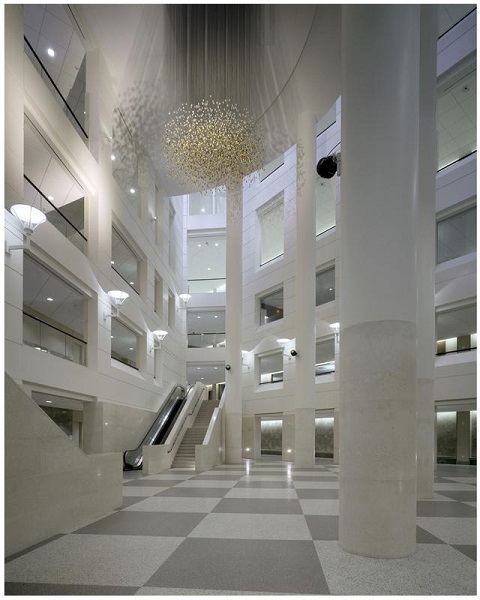Elevators and Escalators
Courthouses generate a high volume of traffic during the course of a day. A clear and adequate circulation system using stairs, escalators, and elevators is needed in multi-story buildings to move people expediently. Furthermore, many judicial facilities are located in cities where multi-story structures are the most practical and economical. Because of the height of many modern court facilities, stairs are generally limited to life-safety exit requirements and to quick access between two floors. Stairs also do not permit access for the physically impaired. For these reasons, escalators and elevators have become the primary means of moving people in multi-story facilities. Both elevators and escalators have their uses, and one system supplements the other.
Escalators - fastest and most efficient way to move a large number of people in an uninterrupted manner, especially between the lower three to four floors. These levels typically contain the most active functions, including the clerk's office, high volume courtrooms, jury assembly areas, the law library, and other highly public areas of the court. These activities necessitate the movement of a large number of people quickly from the public entrance without creating a large queue at the elevator banks. Escalators cannot, however, serve the needs of the physically impaired or disabled and they are impractical for higher floors because of space and time they require to travel six to nine floors.
Elevators - advantageous for moving small volumes of people quickly to the upper floors. Other advantages are their capability to serve the physically disabled or impaired, transporting injured or ill individuals during emergencies, and to move equipment, furniture, and supplies.
The number of elevators planned for a courthouse should be based on a number of factors, including the volume of people at peak periods, the time interval between stops, the cab capacity, and the speed of the elevator. The allocation of courthouse elevators should be calculated on the highest capacity of riders during peak times of the day and week. In addition, separate elevator systems should be planned for moving the public, court staff and judges, and in-custody defendants. Private elevators, which open onto restricted areas of the building, can be programmed to respond to only a card or key access. One of the most common deficiencies found in most older courthouses is a lack of elevators.
 |
Lobby Escalator - Mecklenburg County Courthouse, Charlotte, North Carolina |